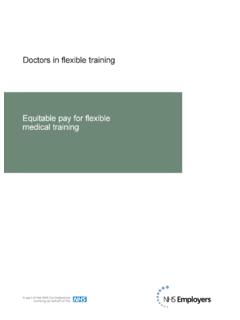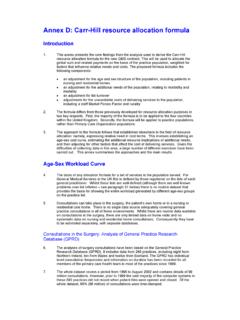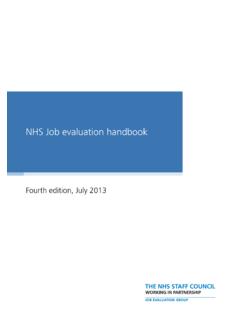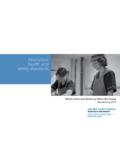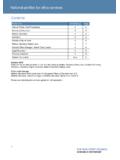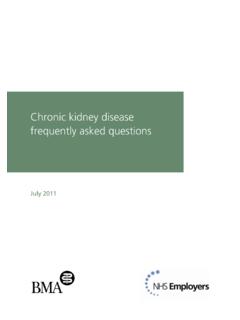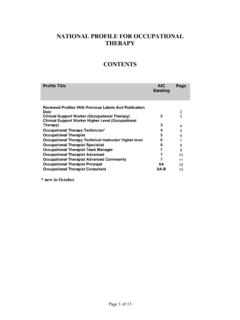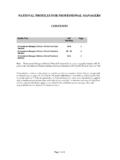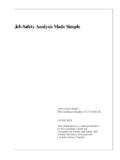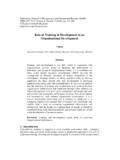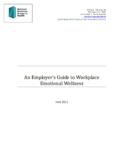Transcription of EMPLOYEE HEALTH AND WELLBEING STRATEGY
1 EMPLOYEE HEALTH . AND WELLBEING . STRATEGY . DRAFT - Version 2 July 2012. CONTENTS. Section Content Page 1 Introduction 3. 2 Aims of the STRATEGY 4. 3 Background 4. 4 What is a Healthy Workforce/Workplace 5. 5 What is HEALTH and WELLBEING 6. 6 Current HEALTH and WELLBEING Status 6. 7 Demographic Profile of Employees of 8. employees 8 Current HEALTH and WELLBEING Activities 9. with the Trust 9 We are Here For You/Better for You 12. 10 Implementation of the STRATEGY 12. 11 Action Plan 15. 12 Partnership Working 15. 13 Monitoring and Evaluation 16. 14 Equality and Diversity Statement 16. 15 Equality Impact Assessment Statement 17. Terms of Reference for the HEALTH and Appendix 1. WELLBEING Group Equality Impact Assessment Appendix 2. 2. EMPLOYEE HEALTH AND WELLBEING STRATEGY . 1. Introduction NUH recognises that our employees play a vital role in our progress towards our 2016 vision of becoming the best acute teaching hospital.
2 Our employees have a direct impact on the clinical outcomes and the experience of our patients. We are clear that when our staff are felling well and satisfied with their work, the experience of our patients improves. This EMPLOYEE HEALTH and WELLBEING STRATEGY supports the Trust's overarching Workforce STRATEGY which sets down a commitment to become the best place to work by 2016. It acknowledges that the work and the HEALTH and WELLBEING of our employees are interlinked, and the Trust's commitment to promoting a culture where WELLBEING is embraced by all our employees. Through the STRATEGY and the supporting action plan, we will provide a framework for NUH to take a proactive and engaging approach to enhancing the HEALTH and WELLBEING of our staff. This will be achieved through WELLBEING initiatives, EMPLOYEE support mechanisms and joint working with staff and their representatives, and local partners to identify and address areas for improvement.
3 By regularly undertaking a staff HEALTH needs assessment questionnaire we will work with employees to ensure our organisation identifies and minimises those issues which may impact negatively on staff HEALTH . We already have a number of effective policies and procedures in place to support EMPLOYEE HEALTH and WELLBEING at NUH. We will continue our regular review of these to ensure that they support this STRATEGY . Our nationally recognised HEALTH and WELLBEING programme (which incorporates the physical activity programme formally known as Q Active) will continue to underpin many of the initiatives we will develop. NUH recognises that its employees are from a range of backgrounds with different cultures, beliefs, abilities and sexual orientations. We will ensure that any initiatives suggested or implemented take into account these differences so that we do not knowingly preclude any particular group from participating.
4 We will provide training, guidance and support to managers so they have the necessary skills, knowledge and ability to support employees to improve their 3. HEALTH and WELLBEING . We will also ensure that though a variety of means we provide information and support to our employees to increase their awareness of the importance of ensuring their own HEALTH and WELLBEING and in particular the correlation between positive emotional and mental HEALTH WELLBEING and exercise. 2. Aims of the STRATEGY The STRATEGY aims to: 1. Create a safe and healthy working environment 2. Improve physical and emotional WELLBEING 3. Encourage and support employees to develop and maintain a healthy lifestyle 4. Support people with manageable HEALTH problems or disabilities to maintain access to or regain work 5. Improve staff satisfaction, recruitment and retention 3.
5 Background HEALTH and WELLBEING is increasingly being acknowledged as a vital element in supporting and developing the workforce. Not only are there positive benefits to staff and patients there are also financial benefits to the organisation Since the first version of the NUH HEALTH and WELLBEING STRATEGY was published in June 2010 the original work undertaken by Dame Carol Black and Dr Steve Boorman has been further developed. Further sources of information and guidance are now available to further shape our STRATEGY and of most relevance are NICE public HEALTH guidance for the Workplace The Responsibility Deal The NHS HEALTH and WELLBEING Toolkit HEALTH and WELLBEING is also now identified under a QIPP. Quality healthier, more motivated staff have been shown to deliver better, safer, higher-quality care on a more consistent basis.
6 4. Innovation staff-driven HEALTH and WELLBEING initiatives have the potential to begin the culture change needed to encourage innovation at all levels within the NHS. Productivity reducing sickness absence will mean more staff are at work, improving morale and reducing stress. Coupled with better staff engagement, this is a powerful way to improve patient care and productivity. Prevention raising staff awareness of how to prevent ill- HEALTH in their own lives and introducing innovative models for staff WELLBEING in the workplace will encourage staff to become strong advocates for prevention, passing on ideas and practice to patients. 4. What is a Healthy Workforce/Workplace? A healthy workforce can be defined as: A healthier, happier workforce Motivated employees with increased morale EMPLOYEE retention and lower EMPLOYEE turnover Reduced sickness absence Good EMPLOYEE /management relations A healthy workplace can be defined as: A positive image in the eyes of both employees and service users A place where HEALTH risks are recognised and managed if they cannot be removed A place where work design is compatible with people's HEALTH needs and limitations An environment that supports the promotion of healthy lifestyles A place where employees and employers recognise their responsibility for their HEALTH and the HEALTH of colleagues Source: The healthy workplaces handbook The NHS reference guide to staff WELLBEING (2007)8.
7 5. 5. What is HEALTH and WELLBEING ? HEALTH and WELLBEING is about being emotionally healthy as well as physically healthy. It's feeling able to cope with normal stresses, and living a fulfilled life. It can be affected by things like worries about money, work, your home, the people around you and the environment you live in. Your WELLBEING is also affected by whether or not you feel in control of your life, feeling involved with people and communities and feelings of anxiety and isolation.. Source: National Institute for HEALTH and Clinical Excellence (NICE) 10. 6. Current HEALTH and WELLBEING Status Since the first version of this STRATEGY was published in 2010 NUH has made significant progress on a number of key HEALTH and WELLBEING indicators. Workforce Data from the Electronic Staff Record 2009/10 2011/12.
8 Staff in post 12800 13500. Sickness Absence rate Number of staff off sick 382 349. for more than 28 days with a musculoskeletal problem Number of staff off sick 380 299. for more than 28 days with mental HEALTH problems Staff Turnover 6. Given that the Trust's headcount is circa 800 more in 2012 than in 2010 the reduction in the number of staff off work for more than 28 days with musculoskeletal or mental HEALTH related problems is probably under-stated. Staff Survey Data 2009 Staff Survey 2011 Staff survey Percentage of staff 21% 16%. suffering a work-related injury in the last 12. months Percentage of staff 33% 25%. suffering from work related stress in the last 12 months Work pressure felt by staff Support from immediate managers Impact of HEALTH and WELLBEING impacting on ability to perform work or daily activities Staff Job satisfaction Trust commitment to work-life balance These indicators show performance' at a Trust wide level, although there are many differences in performance throughout Directorates across the organisation.
9 7. There is clearly much more to do to further improve the HEALTH and WELLBEING of our staff but the comparative data above indicates that to date our HEALTH and WELLBEING STRATEGY is having a positive impact. 7. Demographic Profile of Employees The demographic profile of our employees can provide some useful pointers to their HEALTH needs. It is also important however that we engage our employees in the implementation of the STRATEGY in order to establish what specific HEALTH needs they may have: NUH now has over 13500 employees compared to12800 in June 2010. 11% of employees were of ethnicities other than White British compared to a figure of for the resident population of Nottingham (there are a significant %. of staff who have not declared their ethnic origin). Around 34% of employees are aged 35 and under Around 25% of employees are aged 51 and over Over 76% of employees are women 9% of Nottingham residents are carers.
10 It is reasonable to assume a higher % of employees are carers given the large proportion of females employed, although the Trust recognises that male employees may also have caring responsibilities. 76% of employees are on band 6 or lower pay scales 39% of employees work less than full time hours The HEALTH and WELLBEING of employees can be linked to a certain degree to the general HEALTH and WELLBEING issues of the people of Nottingham and surrounding areas. The key issues that impact adversely on the HEALTH of the population are related to socio-economic factors such as poor housing, low educational attainment, unemployment and low income. Nottingham City is ranked as the 13th most deprived district in England in the 2007 indices of Deprivation. Although there is no direct comparison between employees and Nottinghamshire residents, employees and their families are likely to be affected in some way by the wider HEALTH issues within the community: 8.
